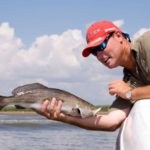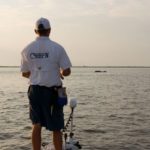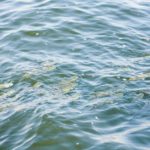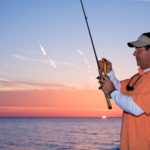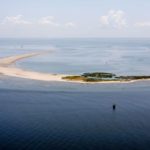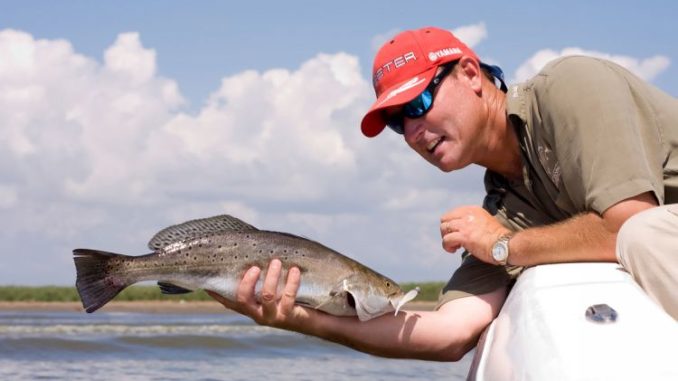
A mess of trout live in the summertime surf. Here’s how to catch them
When most folks from Louisiana want to spend a little time at the beach, they pack up their SUVs and head east toward Gulf Shores, Alabama.
When Joey Hedrick wants to spend a little time at the beach, he hooks up his boat and heads south toward Last Island.
“I love it,” he said as he began explaining why he foregoes his toes in the water and butt in the sand for his bait in the water and rod in his hand. “You might say I’m a different kind of beach bum.”
“Last Island is my favorite of all the beaches I fish,” he went on. “I fish them all from Grand Isle to Elmer’s to the Timbalier Islands, but Last Island has been the best for me.”
Hedrick, who mainly fishes out of Cocodrie, loves to fish beaches during the summer because he loves the peace and serenity that comes with fishing them first thing in the morning when there is usually a lot of bait, clean water, and tons of trout.
“From Grand Isle to Elmer’s to the Timbaliers, they all have that sand element that creates beaches along the shorelines,” Hedrick said. “And trout spawn on those sandy bottoms on the full moons from May through August. There’s just a lot going on around these beaches that make them perfect spots for summer fishing.”
Although he fishes all the islands and beaches out of Cocodrie, Hedrick says what he has learned from primarily fishing Last Island has served him well at all the others.
“It’s just a handful of small things, really,” he said. “Just some things I’ve learned that I think will work no matter where you’re fishing a beach this summer.”
Run the troughs
When first analyzing a beach to see how he wants to fish it, Hedrick pays close attention to where the water is breaking. This shows him where the troughs — long depressions that are deeper than the surrounding bottom — are and how they run.
“Most beaches have at least two troughs,” Hedrick explained. “There’s one close to the shore, and there’s a second one out a little deeper than that typically where you’re boat is sitting when you’re fishing the first one.”
Many of these troughs run parallel to the beach or at a slight angle to it depending on how the tide affects the area. Some may be hardly more than a foot deeper than the surrounding bottom; some may be much deeper.
Finding these troughs is relatively easy for someone who knows how to read the waves breaking over them.
“There is a sandbar between the two troughs that will pushes the water up as it hits the shallow water,” Hedrick said. “That wave will break somewhere between them and crash into the first one up by the shore. Where a wave falls over into the first trough and crashes onto the beach is where I’ve made some good memories.”
Hedrick has found over the years that the largest trout around often hang out in that zone from the first trough to the shore. He reasons that the troughs give these big fish a break where the current isn’t as strong and gives them a perfect ambush spot where they can dart up and gorge on disoriented baitfish scattered by crashing waves.
Time the tide
Hedrick believes the best time to be fishing beaches is in the first hour at the beginning or ending of an incoming tide. When that time corresponds to the early morning hours, he likens it to the stars aligning for a perfect trip.
“There’s no better time to fish beaches,” he insisted. “The trout are already up there wanting to eat and the beginning or ending is just the icing on the cake. The troughs have a lot to do with the water movement, but it kind of stacks up against the beach and kind of wraps around the island.”
If the beach is close to a pass the water would move a little differently closer to the pass.
“As you fish toward the pass you’ll see the water moving more at a slight angle,” he said. “It moves down the troughs and they become a little slanted rather than parallel because of the water movement. Of course you can spot this if you’re able to read the waves crashing.”
Be aware of the bait
Obviously finding bait is a big part of finding trout on beaches. Being so close to Gulf water, Hedrick says he stays on the lookout for what he calls “trout water” because it helps him find bait.
“It’s clear but not too clear,” he said. “You might be able to see a foot down in the water, and you can see schools of finger mullet or pogies swimming. If you’re fishing a stretch without a bite and you don’t get bit, just move around until you spot bait in the water.”
Of course there are other ways to find bait. Like every other angler on the water, Hedrick lets diving birds point him to the right spots.
“You can rest assured that if you’ve got birds diving around a beach there is bait underneath them,” he went on. “And if you happen to find some pogies, that’s where you should hunker down and fish hard because the big trout will be somewhere around them.”
Sometimes Hedrick finds bait oriented around structures in the water. Jetties, rockpiles, anything that sticks out and is different than the surrounding area can be good because bait just likes to get around this kind of cover.
Fishing beaches
Depending on how hard the wind is blowing, Hedrick prefers to approach a beach from the outside and work his way in.
“I try not to just crash in on them,” he said. “I like to ease up to them on that first trough and use a 7-foot casting rod to make a long cast to get to the fish. I look for that break and ease up to where I can get my bait over in there to where the wave is breaking.”
The wave action creates a perfect situation for fishing the bottom with a drop-shot rig or a Carolina rig. Hedrick bumps either rig on bottom right into the turbulent water. Fish running the break typically pick it up as the bait flutters around in the surf.
“I bring live bait, but plastic isn’t all that bad either,” Hedrick went on. “But as we go a little further into summer, the soft plastic bite kind of dies off a little bit.”
Although he brings live bait with him every trip he makes to Last Island, Hedrick says the first hour of daylight is a perfect time to break out the plastics, especially if it coincides with either the first or last hour of an incoming tide.
He frequently begins his morning tossing tandem or single rigged cocahoe-style plastics into the breaking waves. After letting his baits hit bottom, he tries a few different retrieves until he figures out what the fish want.
“Sometimes they want it bumped on bottom, and other times they want it swimming just over the bottom,” Hedrick said. “My two favorites are the Matrix Shad and Dudley Bay Chovey. Both seem to outperform some of the other ones for me.”
During the earliest part of the morning, Hedrick has had more success on some of the lighter iridescent clear colors like shrimp; however, he switches over to more opaque colors like avocado or purple/chartreuse after the sun comes on up.
“You can also try either of those plastics on a drop-shot or Carolina rig,” Hedrick noted. “I’ve done well with this set-up rigging them on 1/8-ounce jigheads and longer leaders. The more room you can give them between the weight the more room they’ll have to dart around naturally in the water. A longer leader gives them room to flutter.”
An exasperated grunt escaped from Hedrick’s throat when I asked him about topwaters or hard-plastic sinking or suspending baits. It was almost as if he didn’t even want to talk about them.
“I love both,” he relented, “especially if I see pogies in the water because big trout will be around those pogies, and big trout love both of these kinds of baits. I’ll fish a big walking bait early if I’m around pogies. Other than that I love that little MirrOdine — the one that suspends down about a foot. Those things are deadly. Trout will dang near take the rod out your hand.”
When the initial flurry of action begins to die down on the first trough, Hedrick likes to back off and fish the second, deeper trough.
“Seems like as we move on into the summer trout don’t stay on that first trough as long,” he explained. “They’re not nearly as easy to find and fish, but once you get on it you can stay on the bite.”
Hedrick says that the second trough produces the same kind of surface action as the first trough, but it is much more subtle and hard to spot. Rather than a crashing wave, there may just be a swell in the water that would probably go unnoticed unless you were looking for it.
“Once you get on it just use your electronics to stay around it,” he said. “Fish the same stuff you fished on the first trough. The only difference I’ve really seen is that you don’t have to put it on the bottom as much when you’re fishing the second one. A swimming action with the plastics — if they’re still biting them — seems to work a little better for me in that deeper water.”
If you’re fishing live bait on the second trough, Hedrick advised using longer leaders to help hold the bait up in the water. Whether you’re using shrimp, croaker, or whatever, the longer leader allows it to swim and flutter around much more naturally.
Because beaches are located either directly on the coast or around barrier islands, the weather can play a big role in making the decision to fish beaches.
“For me I look for a light wind,” Hedrick said. “If we’ve got a harsh wind — say 20 miles an hour — that’s going to make it really rough on you. If it’s blowing opposite the tide it’s going to make for a rough ride just to get there.”
Hedrick also looks for a tidal range of one foot or less.
“One of the best trips I ever had at Last Island there was virtually no tide,” he recalled. “Maybe 1/3 of a foot. We had the kids and decided that we’d go anyway. It was as good as it could be — light wind, light tide, and the bait was stacked up on the beach.”
Island beaches — especially if they offer beaches on all sides — offer an opportunity for anglers to get out of the wind no matter which way it’s blowing.
“Depending on the island, sometimes how it’s laid out can be a big benefit,” Hedrick said. “We get a lot of east and southeast winds this time of year which leaves you exposed on the southern and eastern sides of an island. Maybe you can tuck in behind the island or behind a little point. It’s definitely a “Plan-B” type of deal if you get out there and the wind starts blowing.”
Where you fish on the island also has a lot to do with tide. Hedrick says he likes to fish the front side of an island with an incoming tide and the back side of an island on a falling tide.
The Redneck Riviera to our east may offer a different kind of summer fun, but for speckled trout anglers, it just doesn’t get any more fun than fishing beaches during the summer.
You don’t even have to be a beach bum to get in on the action. It’s going to be there waiting on you wether you live on the beaches or just head there for a long weekend.
